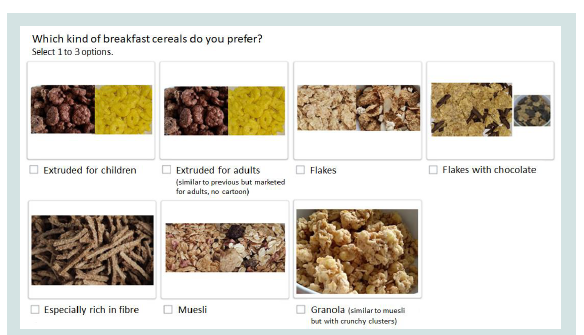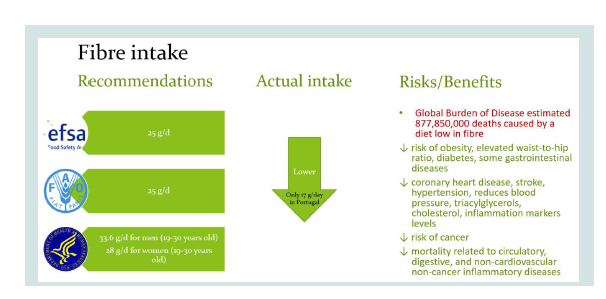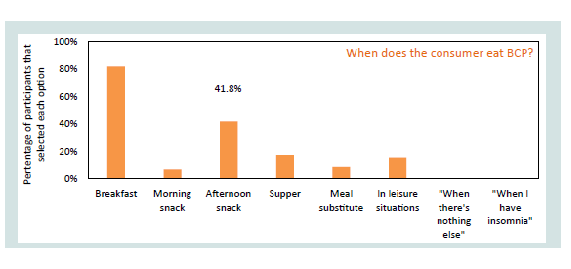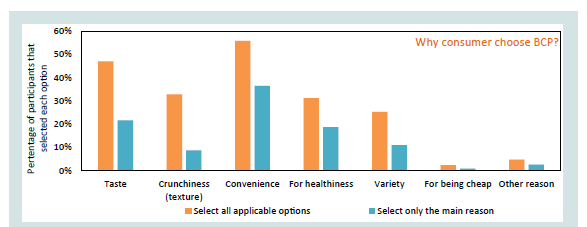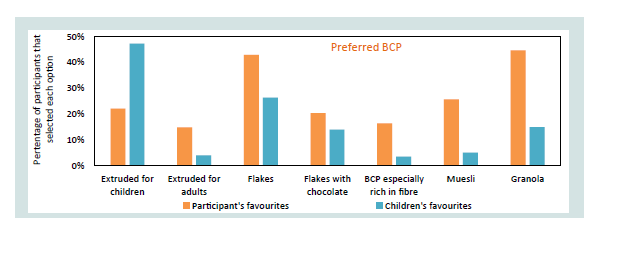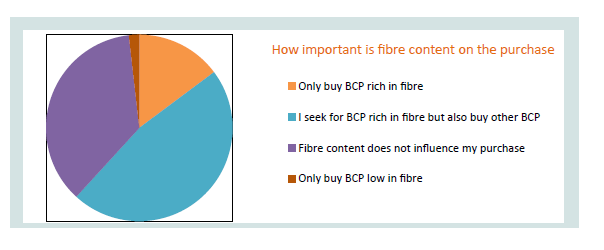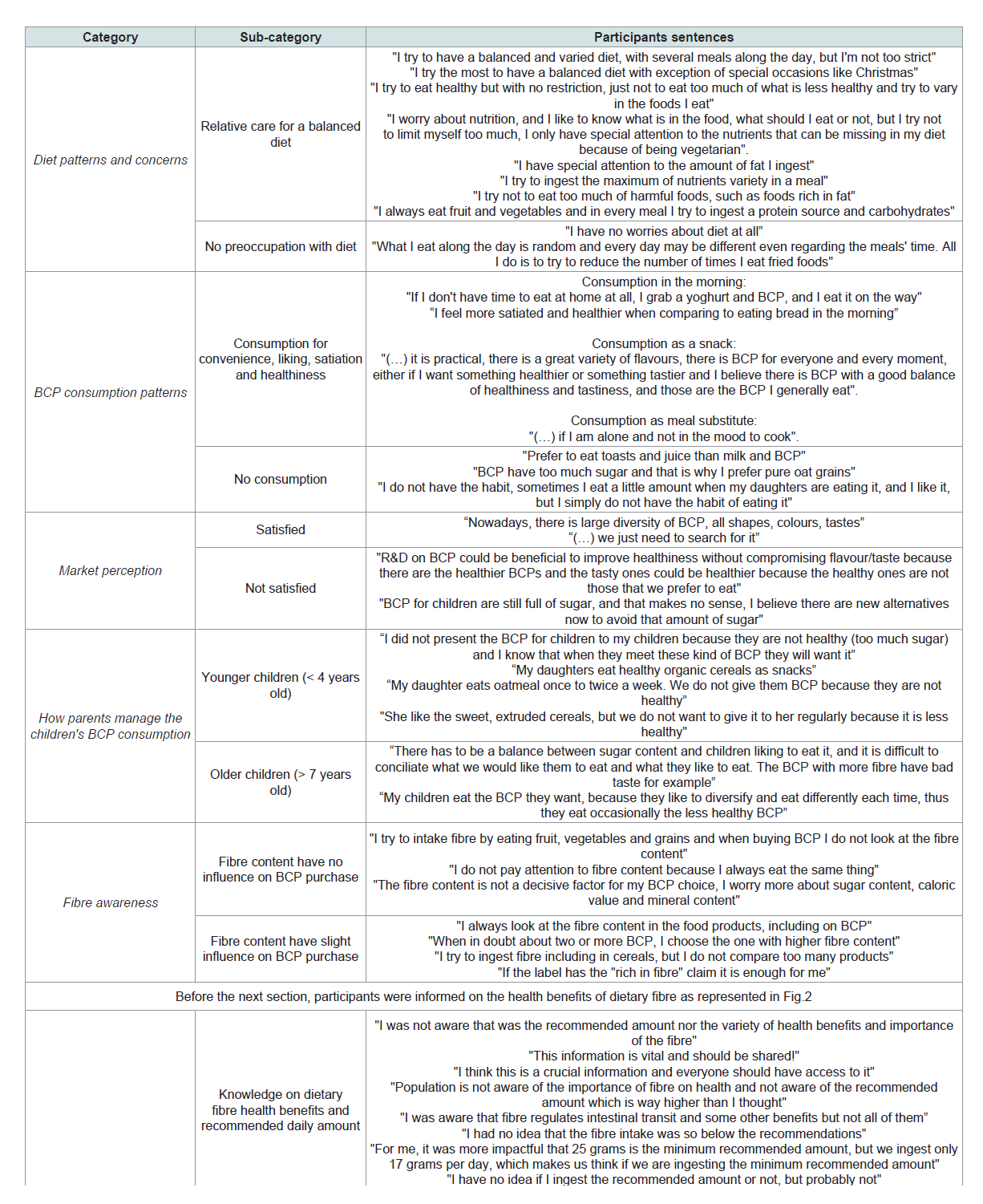Journal of Food Processing & Beverages
Download PDF
Research Article
Breakfast Cereal Products Consumption and Consumer Preferences: A study on Dietary Fibre Content Awareness
Diva Santos1, José A. Lopes da Silva2, Elisabete Pinto1* and Manuela Pintado1
1Universidade Católica Portuguesa, CBQF - Centro de Biotecnologia
e Química Fina – Laboratório Associado, Escola Superior de
Biotecnologia, Rua Diogo Botelho 1327, 4169-005 Porto, Portugal
2LAQV-REQUIMTE, Department of Chemistry, University of Aveiro,
3810-193 Aveiro, Portugal
*Address for Correspondence:
Elisabete Pinto, Universidade Católica Portuguesa, CBQF - Centro de Biotecnologia
e Química Fina – Laboratório Associado, Escola Superior de
Biotecnologia, Rua Diogo Botelho 1327, 4169-005 Porto, Portugal Email:
ecbpinto@ucp.pt
Submission: 02-November, 2022
Accepted: 15-December 2022
Published: 19-December 2022
Copyright: © 2022 Santos D, et al. This is an open access article
distributed under the Creative Commons Attribution License, which
permits unrestricted use, distribution, and reproduction in any medium,
provided the original work is properly cited
Abstract
It is well established that BCP could have several health benefits,
mainly related to its fibre content. This study aimed to evaluate the
BCP consumption in Portugal, the reasons behind the consumers’
choices, and evaluate consumer awareness on fibre content and
health benefits. The hypotheses were that i) consumers are not aware
of the dietary fibre benefits nor the relationship between daily intake
and benefits; ii) BCP are a good strategy to increase fibre intake.
The novelty of this work is related to the fibre awareness evaluation
and whether the increase in fibre content on BCP could increase
its consumer interest. A cross-sectional study with both quantitative
(survey) and qualitative (focus group) approaches was performed. A
total of 1126 participants completed the survey, and two focus group
were performed, one focus group with people with 24-31 years old
and another with parents with ages between 33-41 years old. It was
assessed the effect of parenting on BCP perception, consumption,
and purchase. More than half of the Portuguese population consume
BCP at least once a week, mainly at breakfast, for convenience, taste,
and healthiness. Granola and flakes are the mainly consumed by
adults, and extruded and flakes by children. Consumers identify a lack
of products that combine taste and healthiness.
Fibre content does not determine the BCP purchase, and
consumers are not aware of all the health benefits of fibre nor its daily
recommendation. When enlightened, consumer defended that this
information should be shared massively, as well as how to achieve its
recommended amount. The BCP approach is different among adults
with or without children. Consumers demand for healthy & tasty BCP.
Informed consumers on fibre benefits (besides the satiety and intestinal
health) and daily recommended amount have higher willingness to
purchase BCP rich in fibre.
Keywords
Breakfast Cereals; Ready-to-Eat Cereals; Consumer
Awareness; Dietary Fibre
Introduction
Many studies have determined the health benefits of dietary
fibre (DF). A more recent Global Burden of Disease study estimated
877,850,000 deaths caused by a diet low in fibre (less than 23.5 g/d)
[1]. Higher total DF and insoluble DF intake is highly associated
with a lower risk of overweight and elevated waist-to-hip ratio, blood
pressure, cholesterol, triacylglycerols, and homocysteine [2]; lower
risk of circulatory, digestive, and non-cardiovascular non-cancer
inflammatory diseases [3]; cereal and fruit fibre intake is related with
decreased risk of diabetes [4:5]. On the contrary, a diet high in rapidly
absorbed carbohydrates and low in cereal fibre is associated with risk
of type 2 diabetes [4], and gestational diabetes risk [5].
Both European Food Safety Authority (EFSA) and Food and
Agriculture Organization (FAO) recommend a minimum DF intake of 25 g/day [6] and the U.S. Department of Health and Human
Services recommend 33.6 g/day for men between 19-30 years and 28
g/day for women of the same age [7]. However, the intake amount is
still under the recommendations in EU countries [6,8] and the USA
[9].
Breakfast cereal products (BCP) are widely consumed world
wide(1.6 kg per capita in 2020) [10], and due to its popularity and
nutritional profile (carbohydrates as the main ingredient), this
product could represent a good strategy to increase fibre intake. The
higher consumption per capita is found in North America (6.8 kg/
capita) [11], followed by Europe (4.5 kg/capita)[12] and Australia &
Oceania (2.7 kg/capita) [13]. The lowest consumption levels occur
in Africa and Asia (both 0.7 kg/capita) [14,15]. In Portugal, half
of the population consumes BCP [16], similarly to other countries,
namely, Australia [17], Spain [18] and UK [19]. Previous studies
have demonstrated that the average intake of breakfast cereals is
higher among children than among adults [19,20]. In Portugal, the
overall average consumption is 15 g/day; for 10-17 years teenagers, it
increases to 26 g/day, and for children under ten years old, the daily
intake is 29 g [21].
Two systematic reviews on studies comprising nutrient analysis
of breakfast cereals, concluded that BCP help reduce cholesterol,
improve bowel function, lower the risk of diabetes and cardiovascular
disease, is associated with lower mortality, and its regular consumption
is associated with lower body mass index, lower risk of obesity, and it
is associated with well-being feeling especially those rich in fibre [22-24]. Moreover, the consumption of BCP is associated with healthier
dietary patterns regarding carbohydrates, DF, fat and micronutrients
intake [24].
This study aimed to evaluate the BCP consumption patterns
focused on Portugal as a representative country with Mediterranean
diet; the reasons why consumer chooses this food product, and also
to evaluate the consumer awareness on fibre content and health benefits. Therefore, both quantitative and qualitative approaches were
addressed by an online survey and two Focus Group, respectively.
Materials and Methods
Online survey:
A questionnaire was spread online to collect information on
consumption habits, consumer preferences, and perceptions towards
BCP. It was conducted in the Portuguese language, using Google
Forms, and the mean survey time was 5 minutes. The inclusion criteria
were living in Portugal, reading and understanding the Portuguese
language, and being at least sixteen years old. The socio-demographic
characteristics that were collected included age, gender (male, female,
rather not say), living region, nationality, education (lower than high
school, high school, technical school, university degree or higher),
occupation, number of people in the house and number of children
under 18 years old living in the house. The questionnaire was open to
answers for four months (from July to October 2020), and the sharing
was encouraged at the end of the questionnaire.The main objective of the survey was to understand how regularly
the consumer eats BCP (do not consume, less than once a week, 1
to 2 times per week, 3 to 6 times per week, 1 or more times per day)
and why (taste, texture, convenience, healthy, the variety of products,
money-saving or other). What kind of products were preferred
(flakes, flakes with chocolate, granola, muesli, extruded cereals for
adults, extruded cereals for children, breakfast cereals especially rich
in fibre – exemplary images were given with the question, see Figure
1) was also questioned. In the case of having children, participants
also indicated which breakfast cereal products are preferred to give
to their children. Consumers were asked about their choice criteria
(brand, sensory quality, price, healthier, low sugar content, energy
content, salt content, and fibre-rich). It was also asked if the consumer
had the habit of reading nutritional information. The questions
related to fibre content were made to know if the consumer is aware
of fibre intake requirements. An additional goal was to understand
if the provision of fibre-related information would have an impact
on the importance given by consumers to this nutrient. The group of
questions about fibre were:
i. Do you give importance to the fibre content at the moment of
purchase?
ii. Did you know that it is recommended to intake at least 25g
per day of fibre?
iii. Which one of the following do you know as a benefit of fibre
intake? (I do not know, regulation of intestinal transit, lower
risk for obesity, lower risk for hypertension, lower reduces
triacylglycerols, lower risk for high cholesterol, reduction of
risk for some cancers, lower risk for related digestive diseases,
lower risk for diabetes).
iv. It was given the information about fibre intake health benefits
(all of the above) when fibre intake is at least 25 g per day and
that in Portugal, the mean fibre intake is only 18 g per day.
Then it was asked: Does this information make you want to
be more aware of fibre content in cereals products? Why?
For participants that answered not to consume BCP, the above
questions were not made, and instead, it was asked what they eat at
breakfast, why they do not consume BCP and if they would consider
buying (7-point scale from 1-definitely would not consider to 7-
definitely would consider) a BCP with high fibre content, health
benefit-nutritional composition that would taste good and contribute
to food industry sustainability.
Focus Group:
In order to collect consumers’ beliefs, opinions, and attitudes
towards breakfast cereals as a meal and the products in the Portuguese
market, two focus group (FG) interviews, with eight participants each,
were performed. Participants were recruited among the university
community. In one FG, participants were between 24 and 31 years
old with no children, three men and five women. The other FG had
four men and four women, ages between 33 and 41 years old, with
one to two children.FG were conducted online via video conference calls (via
Zoom software since were organised during COVID19 Pandemic)
and recorded after all participants signed informed consents and
agreed with the recording. After the video calls, the meetings were
transcribed to text by question/topic. Afterwards, the information was
analysed and organised by topics, highlighting the main conclusion,
and pointing out the other different ideas that participants pointed.
The questions concerned the following main topics: (i) type of diet
and most important concerns about diet and foods; (ii) BCP choice
and why; (iii) BCP choice for the children and why (question only
applicable for the FG with parents); (iv) importance given to the fibre
in one’s diet and for the choice of BCP; (v) how the given information
about fibre benefits and recommended intake amount can influence
diet and purchase choices. After question iv, information about fibre
benefits was provided as represented in Figure 2 and the influence of
this information was then discussed with question v Figure 1.
Figure 1: Choice options on the question about consumers preferences
among types of breakfast cereals.
Figure 2: The image that was presented to FG participants concerning fibre
intake recommendations compared to the actual intake, and health benefits
related to the fibre intake on the recommended amount [1-9] .
Statistical analysis:
Online survey data was analysed using SPSS version 22 software
(SPSS Inc., Chicago, IL, United States). A chi-square exact test was
performed to assess differences between gender and age groups.
Statistical significance was defined by a p < 0.05. Qualitative research
(Focus Group) data was analysed using the content analysis method
[25]. First, it was performed a pre-analysis consisting in a free floating
reading and structuring the categories and sub-categories.
Afterwards, the interviews texts were allocated to each sub-category.
The interpretation of data was performed by merging theoretical
concepts and empirical data.Results
Breakfast cereals consumption: quantitative study (online survey):
The online survey allowed to collect information about BCP
consumption patterns. A total of 1126 participants completed the
survey, of which 81.6% were women and 3 participants selected
“rather not say”. There was a wide age distribution; 36.3% of
participants were 18 to 30 years old, 25.8% were 31 to 40 years old,
21.1% were 41-50 years old, 13.2% were 51 to 60 years old, and 3.6%
were 61 to 80 years old. Only 3.5% of participants were not Portuguese
(the majority from Brazil (n=26) and Spain (n=4)). The majority
had a high education level (82.4% had an university degree), which
is mainly due to the questionnaire spread method and the lower
internet skills of lower education level people. This sample is not fully
representative of the level of education in Portugal, where only 21.2%
of the population has a high education level [26]. There were 42% of
participants that have children living in the same house. Most of the
participants [59.9%] are BCP consumers and the following results are
relative to the participants that consume BCP.Consumption moment and frequency: More than half of the
respondents consume BCP (59.9%, 674 individuals).Of those, 81.9%
eat it at breakfast, 42.8% during the afternoon, 17.4% at supper, 15.6%
in leisure situations, 8.9% as a meal substitute and 7.0% in the middle
of the morning (Figure 3). More commonly, consumer eats BCP‘
1 to 2 times a week’ (32.5%) or ‘3 to 6 times a week’ (32.3%). Fewer
participants selected ‘Less than 1 time a week’ (24.6%), but the option
with fewer choices was ’1 or more times per day’ (10.5%).
Figure 3: Percentage of participants that consume breakfast cereals that
selected each option about when they consume breakfast cereals.
Consumption choices: When asked for the reasons to consume
BCP, the most selected reason was convenience (55.8% of the
participants selected this option) (Figure 4), followed by taste
(47.0%), crunchiness (32.8%), healthiness (31.2%) and because there
is a large variety of BCP (25.2%). The “Other reasons”(4.7%) that the
participants most pointed were related to varying the breakfast, as they
indicate that sometimes they consume BCP to shift their common
breakfast or because they “do not always have bread available in the
morning”, as mentioned by some participants. Two other reasons
that were pointed out were (i) related to constipation/regulation of
intestinal transit and (ii) related to satiety; participants indicated that
with BCP, they feel “less hungry all morning”(4/34 participants in
each reason).
After the question where the participants could select more than
one option, it was asked to select only the one main reason to buy and eat BCP (Figure 4). For 36.5% of the participants, the main reason
was convenience. The taste was the main reason to 21.7% of the
respondents healthiness was selected by 18.7% of the participants, the
variety of products by 11% and crunchiness by 8.8%.The other reasons
that participants indicated were for satiety all morning (4/13), to vary
breakfast (2/13), to regulate intestinal transit (1/13), for the presence
of fibre (1/13), by indication of a nutritionist (1/13) and to be able to
consume yoghurt in the morning. There were significant differences
among consumers with different ages (p<0.001) in this question. For
older participants (age > 51 years old), healthiness was the main reason
to consume BCP, 51% of the 51-60 years old consumers and 45% of
the 61-80 years old participants selected healthiness. In contrast only
7% of the 18-30 years old consumers selected healthiness, 13% of the
31-40 years old consumers and 26% of the 41-50 years old consumers.
This may indicate that older adults have more tendency to believe in
the healthiness of BCP than younger adults or older adults are more
worried about healthy eating. For the younger consumers the main
reason to consume BCP was convenience, 41% of the 18-30 years
old consumers and 44% of the 31-40 years old consumers selected
convenience and few older consumers selected convenience: 22% of the
51-60 years old consumers and 10% of the 61-80 years old consumers.
Figure 4: Percentage of participants that selected each option about what the
reasons are to consume breakfast cereals. The first column corresponds to
the question where it was asked to the participant to select all the applicable
option and the second column correspond to the question where it was asked
to the consumer to indicate the main reason (and only one) to consume
breakfast cereals.
The next questions were related to the type of BCP that consumer
prefers and the BCP that their children prefer (Figure 5). The
percentages are related to the total of participants that answered the
questions. The first question about the participants favourite BCP was
answered by 674 participants and the second question about the BCP
that are preferred by the participants’ children was answered by 201
participants. They could select more than one option and the BCP
were presented in the question divided into groups: i) flakes, ii) flakes
with chocolate, iii) granola, iv) muesli, v) extruded cereals for adults,
vi) extruded for children, vii) breakfast cereals especially rich in fibre.
Figure 5: Percentage of participants that selected each option about their
preferred breakfast cereals (first column) and the breakfast cereals that are
preferred by participant’s children (second column).
Granola (44.7%) and flakes (42.9%) are the most consumed type
of BCP by the participants in general, followed by muesli (25.7%).
The less consumed BCP are BCP especially rich in fibre (16.3%) and
extruded for adults (with no cartoon-like packaging) (14.8%). The
main reason the consumers rarely eat ‘Extruded BCP for adults’ or
‘BCP especially rich in fibre’ is probably related to the taste of these
products. As seen in the previous question (Figure 4), the taste is the
second main reason for the consumption of BCP after convenience,
which is common for all type of BCP.
Children eat mostly ‘Extruded BCP for children’ (47.3%), which
is referred to the BCP with a cartoon-like type of packaging, followed
by flakes.
Nutritional composition awareness and fibre content & benefits: When asked about how often participants read the BCPs’
nutritional information, either the list of ingredients and/or the
nutritional table, the most selected options were ‘Always’ (38.7%)
and ‘Sometimes’ (37.2%). Fewer people indicated that never (7.7%)
and ‘Rarely’ read it (16.3%). A recent study verified that consumers
use food nutrition labels to make purchase decisions (70%), but few
people read them for all foods (38%) and most people (69%) read
them only for selected foods [27].
When asked about fibre (Figure 6), a considerable number of
participants (36.4%) indicated that fibre content does not influence
their choice on BCP purchase. Nevertheless, the majority of
participants said they look for BCP rich in fibre but are flexible on
buying others BCP too. There were 14.8% of participants responding
that only buy BCP rich in fibre. Which aligns with the fact that
16.3% of participants indicated BCP especially rich in fibre as their
favourites (Figure 5).
Figure 6: Percentage of participants that consume BCP that selected each
option about their preference towards fibre content.
It was also performed a statistical analysis to compare gender and
age groups and it was verified that women (compared to men) and
older adults give more importance to the fibre content in BCP. More
women selected the Only buy BCP rich in fibre option (16.3%) than
men (8.7%). Similarly, less women selected the Fibre content does not
influence my purchase (34.3%) than men (46%). Those differences
were significant (p < 0.05) and demonstrates that women give
more importance to fibre intake than men. Comparing age groups,
significant differences were found (p < 0.001). The option Only buy
BCP rich in fibre was mainly selected by 61-80 years old people (40%
of this group selected this option contrast to 10-21% of the other age
groups). And 60% of the 51-60 years old selected the I seek for BCP
rich in fibre but also buy other BCP (45-48% of the other age groups
selected this option).
When the participants were asked “Did you know that, for
an adult, the recommended amount of fibre intake is at least 25 g
per day?”, most of the participants (53.7%) indicated to know that
fibre consumption is important but were not aware of the necessary
daily amount. Only 10.4% answered that did not know and 35.9%
of participants knew the recommended amount. This is a great
percentage of informed people which could be explained by the
high scholarship level of the majority of participants (82.4% have an
university degree).
Then, it was presented the several fibre benefits and it was asked
to participants to select all options that corresponded to fibre health
benefits. ‘Regulation of intestinal transit’ was the most known
benefit once 92% of participants selected that option. ‘Lower risk for
digestive related diseases’ and ‘lower risk for obesity’ were the next
most selected options (46.9 and 46.3%). There are also people that
were aware of the following benefits: ‘lower risk for high cholesterol’
(37.2%), ‘reduction of risk for some cancers’ (33.5%), ‘lower risk for
diabetes’ (30%), ‘lower risk for high triacylglycerols’ (29.8%), ‘lower
risk for hypertension’ (25.8%). Only 6.7% of the participants selected
the ‘I don’t know’ option.
Next, participants were informed that the consumption of a daily
amount of at least 25 g per day of fibre was associated with lower
mortality [3], which is related to the fact that fibre presents all the
benefits presented as options in the previous question [2,28,29]. Then,
it was asked “Does this information make you want to be more aware
of fibre content in cereals products?” and a 5-point scale was given
to the answer where 1 stands for “Absolutely NOT” and 5 stands for
“Certainly YES”. Most people (42.5%) selected point 5 and oppositely
only 3.3% selected point 1 (Figure 7).
Figure 7: Percentage of participants that selected each option.1 stands for
“Absolutely NOT” and 5 stands for “Certainly YES”.
In the next open answer question, people that chose 4 or 5,
indicated that this change of habit was mainly due to willingness for
improving health/well-being or prevent disease (57% answers to this
optional question). Moreover, because of the awareness about the
benefits or the recommended amount versus the actual intake: ”I was
not aware that the lack of fibre could bring so many health problems” or, similarly, “This is a new information for me and a very important
one”, “Knowledge is power”, “I learned what I did not know”. Some
participants referred to the information about the actual DF intake
amount is lower than recommended, e.g., “Because now I know that
the amount I ingest is not enough”, “I had no idea I ingest so low
amount of fibre”.
Some answers more related to the BCP were” Because until now
I was not aware of the nutritional profile of BCP”,”I will now choose
BCP with more fibre”, “Because it is easy to choose the BCP with
higher fibre content”, “[to consume BCP rich in fibre] would be a
quick and simple way of increasing my daily intake of fibre”, “They
are a practical way to obtain the dietary fibre” and “To join the useful
to the pleasant”. It was also referred “For my health and for my family
health” and “Because it is important for my family”.
People that chose 1, 2 or 3 indicated that they were “already
aware of the health benefits of fibre” and “already consume high fibre
amount”; that they pursue fibre intake in other foods and “I steel
valorise the consumption of fruits and vegetables”; “I am going to
give more importance to fibre in BCP but not excessively “and “It
could be an important information but I don’t believe it would be
influencing my purchases”; “I rarely eat cereals thus I only eat for
pleasure and not for nutritional benefit”, or they believe that have
already “a balanced and fibre-rich diet”. Different type of answers was,
“Laziness of reading labels” and “Because I am faithful to a brand”.
Participants who do not consume breakfast cereal products: The participants that do not consume BCP mainly consume bread,
either fresh, toasted or sweetbreads (75.9%) at breakfast. The next
food products more selected were milk/vegetable milk (44.3%),
soluble coffee or cereals drink (39%), fruit (35.6%), butter (32.6%)
and ham and/or cheese (29.8%). Thus, most people eat bread or
toasts with butter, ham and/or cheese and drink coffee or milk. Other
foods (17.4%) indicated by participants included eggs, milkshakes,
oat, homemade granola, fresh cheese, protein supplements or bars,
buttermilk, espresso coffee and soup.
The reasons to not consume BCP revealed that most people
simply just prefer other kinds of breakfast (46.7%). Nevertheless,
also a substantial number of consumers consider that BCP is not
healthy (31.6%). The third main reason for people not to consume
BCP is as simple as that they never created the habit. A small number
of consumers do not consume BCP for disliking the taste (4.6%) or
the texture (4%), which is understandable that only few participants
indicated these reasons, since there is a vast variety of BCP in the
market. Some other reasons pointed out were: (i) related to calories,
sugar content and diet:”I do not feel satiated”, “They are very caloric”
or “(…)have too much sugar”, “Excess of sugar, lack of protein and
fibre”, “My nutritionist said it is not good”, “I am on intermittent
fasting”.(ii) due to not ingestion of milk: “I do not drink milk” or “I
dislike milk” was pointed several times.
Breakfast cereals consumption: qualitative study (focus groups):
Several topics were discussed during the two focus groups which
allowed a deeper understanding about the results on the quantitative
study. The discussions that took place during these sessions are
summarized in Table 1 according to the categories and sub-categories
of data and the correspondent sentences from participants.Discussion
Our study showed that more than half of the Portuguese
population consumes BCP which is slightly higher than the results of
the Mark test market study, which verified that 49.7% of Portuguese
consume BCP, being this consumption more frequent among the
youngest, where 74.0% of individuals that are 15 to 24 years old
consume BCP [16]. The higher percentage of participants that are
BCP consumers in this study may be justified by the fact that those
who consume BCP may be more willing to participate and complete
the survey as they are more related to the matter than individuals that
are not BCP consumers. The high education level of the sample can
also contribute to this scenario. These results are also in alignment
with consumption patterns in other countries where approximately
half of the population eats BCP [17,18].
The online survey results showed that people who do not
consume BCP consider it caloric or not healthy, which aligns with
previous results on products healthiness awareness. [30] found that
consumers consider a healthy snack to be low in calories, fat, salt,
and sugar and high in whole grain, oats, bran, nuts, seeds, pulses, and
fruit. Additionally, studies showed that consumers’ perception of the
healthiness of BCP could be improved when consumer is forced to
evaluate nutritional table and labels combined [31]. Additionally, the
fact that they do not drink milk was often indicated as the reason to
not consume BCP. In fact, 74% of participants that consume BCP,
indicated that consume it with milk (data not shown), which shows
that the main cultural habit of consuming BCP is with milk.
Diet patterns and concerns:
The first question made in both Focus Group intended to reveal
the consumers’ approach towards diet and foods in general. Previous
studies showed that consumer is increasingly concerned about eating
patterns because of the known effect of food consumption on the
health and weight control [32,33]. Consumers in both groups showed
a relative preoccupation with diet and, in general, trying to have a
careful diet, but not too strict. The reason why people may or may
not follow a healthy eating pattern is still not fully understood, but
it is known to be influenced by genetic, biological, behavioural,
psychological and environmental variables [34]. Nevertheless, the
past years’ food trends involve health benefits. Consumer awareness
about the connection between diet and health has increased as well as
the demand for functional and healthy foods. Recent trends show that
consumers have gained awareness about the link between diet and
emotional health, thus demanding functional and healthy food and
ingredients to address mental and emotional health [35].BCP consumption patterns and market perception:
The main reason for the BCP consumption is convenience,
followed by taste and then healthiness. Similarly, a recent survey in
the USA presented the same question and “It is easy to prepare” and
“It is tasty” were the most selected options (83 and 70%, respectively)
and “It is inexpensive” was the less selected option (33%) [27].Focus
Group participants explained that the convenience of BCP in the
morning is important because of the brief time they have for breakfast
but also because they simply like it. The fact that healthiness was the
third reason most selected shows that consumers consider it healthy
even if they mentioned other characteristics in first. It is expected that taste was more important than healthiness because studies have
demonstrated that consumers are not much willing to compromise
on taste for health. Verbeke [36] concluded that willingness to
compromise taste for health depends on socio-demographic features,
but in general, that “is a highly speculative and risky strategic option”.
Portuguese BCP consumers, eat BCP at least once per week, mainly
at breakfast, but they are also largely consumed as a snack. Similarly,
a study with American consumers (USA) participants indicated to
consume ready-to-eat breakfast cereals more commonly (more than
three meals per week) for breakfast and as snacks and less commonly
at lunch or dinner [27].The type of BCP consumed mainly are granola and flakes. The
extruded for children are not very consumed by adults, which is
possibly because they are often perceived as less healthy, as suggests
previous studies [37]. However, children eat mainly extruded BCP
for children (with cartoon-type packaging) and the second BCP
most consumed by children is ‘Flakes’ maybe because it is one of the
most BCP consumed by their parents and also the most commonly
recommended by health professionals as paediatricians because of
their lower sugar content [38]. Adults and children have the major
consumption differences in granola and muesli, being these more
eaten by adults, and in extruded BCP for children, which are more
eaten by children as expected. More than half of the participants
indicated other types of BCP than ‘Extruded for children’ as their
children’s favourite, which could be conditioned by parents’ belief
that these products are “not good to buy for children” as a recent
study concluded [37]. In fact, Focus groups interviews showed that
parenting affects BCP consumption patterns. Among the parents’
group, there were more granolas and muesli consumers than in non parents
group, which could be related to the fact that parents are more
concerned about healthy patterns as models to their children or it
could be related to age (participants of this group are approximately
ten years older that the other group participants) as it is known that
older people are more health conscious [39] in conjunction to the
fact that granolas and muesli are perceived as healthy products [40].
Nevertheless, this belief could be wrong as previous studies showed
that granolas have higher fat and saturated fat content than other
BCP [38,41,42]. Moreover, children targeted BCP are perceived as less
healthy as they have higher energy, sugar and sodium values and lower
content in fibre and protein [43,44].
When asked if they were satisfied with the products on the
market, all participants recognised that there is a wide variety and
BCP for all tastes and needs. In general, participants are satisfied
with the BCP offer. However, there was also the general opinion that
BCP formulations should be improved to combine healthiness and
tastiness. In fact, previous studies already had shown that consumers
are shifting healthiness perception into believing that foods can
integrate both good taste and a high degree of healthiness (Luomala
et al., 2015), which explains the frustration towards the BCP in the.
How parents manage the children’s BCP consumption:
In the Focus Group of parents, it was asked if they gave BCP to
their children, why and what type of BCP children eat. In general,
participants’ answers indicate that younger children (< 4 years old)
eat healthier BCP, and older children (> 7 years old) may eat a larger
variety of BCP (Table 1). It could be simple flakes, flakes rich in fibre, extruded BCP (for children) or granolas/muesli. Children can eat
BCP at breakfast as well as for snacks, with milk, yoghurt or simple.
Parents with younger children are more prone to avoid the children
to get to know the existence of BCP for children1 (and maybe that is
the reason the participants of this group eat only granolas, muesli, or
oat grains or no BCP at all). This behaviour is understandable since
character/cartoon branding influences children’s food choices, mainly
for energy-dense foods [45], and usually, paediatricians and general
practitioners advise against the introduction of these products in the
kid’s diet [46].Fibre awareness:
The fibre content of BCP is not very important for most consumers
since it does not determine the purchase. However, women and older
people seem to give higher importance to fibre content in BCP, which
aligns with previous studies that have been demonstrating that women
and older adults have more healthy eating habits [47]. The quantitative
study showed that 36% of participants are not influenced by BCP fibre
content during purchase. In fact, Focus Group participants who said
that they are aware of fibre importance do not seek fibre, particularly
on BCP, preferring fruits, vegetables, and grains as fibre source. Other
participants indicate that fibre content influences their purchase and
may compare fibre content between BCP when in doubt, as well
as seek for the “rich in fibre” nutritional claim. Similarly, previous
studies demonstrated that front-of-package information about fibre
content increases the probability of choosing a healthy BCP [48,49].
Previous studies on willingness to eat bread revealed that consumers
that are more concerned about health are the ones that are more
willing to eat bread enriched in fibre compared to the consumers
that give minor importance on health benefits [50]. Parents also have
tried that their children intake fibre more through vegetables’ soup,
fruit and vegetables in all meals than by BCP “nevertheless, as they
frequently eat muesli and oat, I have no worries about my children’s
fibre intake amount”. Consumers are not aware of all the health
benefits of fibre or the minimum daily amount necessary to achieve
those benefits and avoid the risks of a diet low in fibre. The reasons
for participants to seek fibre intake are mainly regulation of intestinal
transit and satiety.However, after being informed about fibre intake
recommendations and risks/benefits of fibre intake (Figure 2),
participants indicated that they were not aware of all the health
benefits of dietary fibre nor the daily recommended amount (Table 1).
Similarly, a recent work showed that consumers (even consumers
with background in nutrition) have very low awareness regarding
fibre and health [51]. Participants demonstrated to incredibly valorise
the information on health benefits and daily recommended fibre
intake and even shocked that this is not massively publicised. Another
shared concern was about incapacity to track the amount of fibre that
they consume and suggested that they must be informed on what
they should eat to reach the daily recommended amount (Table 1).
This information makes the consumer get more attention to the
amount of fibre in BCP and possibly choose BCP with higher fibre
content. Previous studies on health concerns topics concluded that
introducing front-of-pack nutritional labelling increases the chances
of consumer choosing healthy BCP by 3.49% in average and fibre
intake increases the probability by 3.24% [48].
Author contributions
Diva Santos contributed to the investigation, acquisition of
data, analysis and interpretation of data, manuscript drafting. José
A. Lopes da Silva contributed by supervising, manuscript drafting
and editing. Elisabete Pinto contributed to the investigation,
conceptualization, analysis and interpretation of data, manuscript
drafting. Manuela Pintado contributed with supervision, funding
acquisition, analysis and interpretation of data, manuscript drafting
and editing.
Acknowledgements
This work was supported by National Funds from FCT - Fundação
Para a Ciência e a Tecnologia through project UID/Multi/50016/2019.
Diva Santos would also like to thank FCT for her PhD grant with the
reference SFRH/BD/143493/2019.


